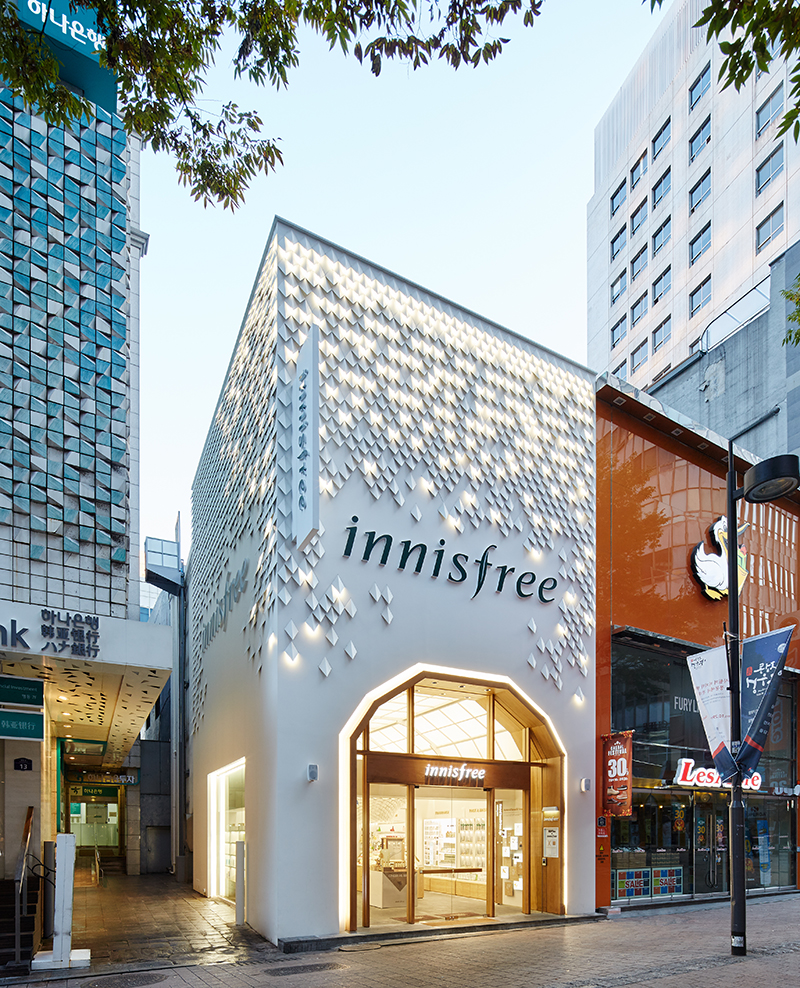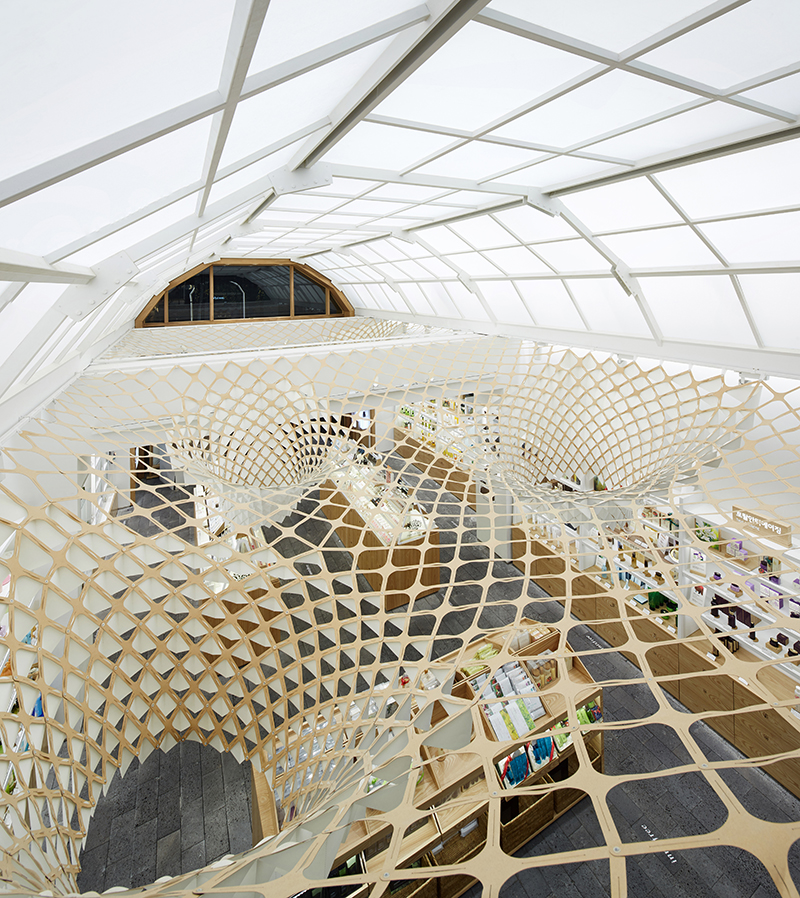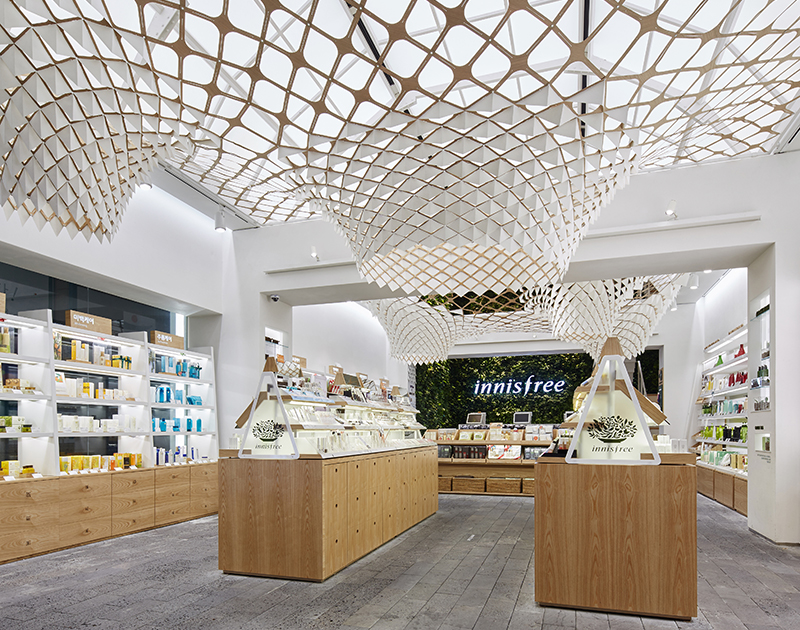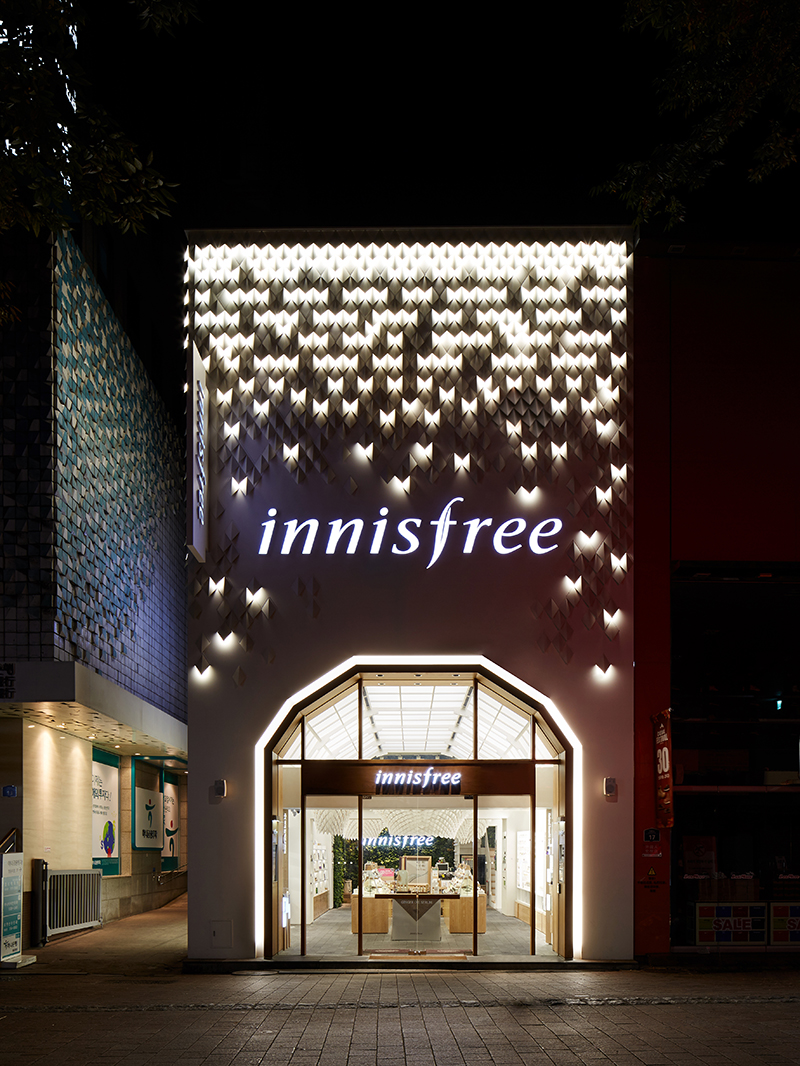Living within a consumer society means that retail environments play a central position in our everyday lives – in fact, retail covers 43% of the total value of commercial property1 and a recent House of Commons report stated that during 2014, consumers in the UK spent around a staggering £378 billion.2
Research has shown that Biophilic Design principles used within retail settings can create an enticing and calming environment for both customers and employees.3 The World Green Business council has recently released a report that highlights key environmental factors that that will optimize retail environments; natural light, improved indoor air quality, acoustics and incorporating biophilic design into the overall look and feel of a retail interior4.

Installation designed by SOFTlab, store designed by Innisfree, photography courtesy of Innisfree
Naturally lit retail spaces can create an energising yet calming atmosphere, which can instinctively attract customers and increase their dwell time spent in the space – leading to an increased number of sales. In fact, an extensive study linking day light to retails sales was conducted in a chain of 73 stores across California – 49 of which relied on artificial lighting. Reports showed that there was a 40% increase in sales after the installation of skylights within these stores.5 In a separate study, Walmart also developed a concept store where only half of it was day-lit, and found that sales per sq. foot were significantly higher within those brighter areas.6

Installation designed by SOFTlab, store designed by Innisfree, photography courtesy of Innisfree
Natural light is an instant mood enhancer, which can have positive psychological effects on employees, improving their motivation, productivity and overall job satisfaction. It can also help to put customers in a more positive buying mood, which further contributes to an increase in sales.
Not only does natural light have physical and psychological benefits, but it can also improve a company’s store economically, by helping to reduce its heating and cooling costs. Walmart stores that were re-fitted with skylights found that profits per square foot, from increased sales were about 20 times the savings in energy costs.7
Experiments demonstrated that retail environments with lower air quality appeared to have lower staff and customer satisfaction level8. Incorporating plants and greenery into a retail space can help to filter pollutants and balance moisture indifferences within the air. Ensuring good air quality can improve staff and customer’s physical wellbeing; minimising health problems including asthma and throat irritation, so by reducing staff absenteeism whilst raising customer satisfaction levels.
Noise pollution has been known to cause many physical and behavioral symptoms, which can have a negative impact on sales by driving customers away and lowering wellbeing and mood of staff. Plants can also help to improve acoustics within a space due to their leaves being good sound absorbers.

Installation designed by SOFTlab, store designed by Innisfree, photography courtesy of Innisfree
The look and feel of a retail space can either stimulate or agitate its users. The exterior of a shop can help to initially attract a customer, whilst the interior can help to retain customers, increasing the likelihood of purchases. The colours red and yellow can provoke excitement and increase blood pressure, which is good for initially attracting customers, whereas blue and green can aid relaxation, which helps to maintain an individual’s comfort during their shopping or working experience.
Incorporating natural elements and greenery can overall improve the aesthetic of an interior as it adds texture, vibrancy and dynamism. This enticing aesthetic can draw customers in and improve their perception of the company’s brand and individual products in store. In a study, Biophilic Design was positively linked to customer’s dwell time and price acceptance due to its restorative quality9.Visiting urban commercial areas can be stressful and attentionally draining for many, however, elements of nature can help customers to restore their direct attention10, making them feel more relaxed and focused whilst shopping.

Installation designed by SOFTlab, store designed by Innisfree, photography courtesy of Innisfree
These Biophilic design principles not only enhance the physical qualities of a retail space, but have many psychological and economic benefits for both customers and employers, alike. In short research suggests that where Biophilic elements are present in retail environments, customers are more likely to stay longer in store, will have a higher perceived value of goods and are more likely to return to the retail outlet.
Additional Reading
1 World Green Building Council. Health, wellbeing and productivity in retail: the impact of green buildings on people and profit.
2 Rhodes, Chris. (2014) House of Commons Library. The retail industry: statistics and policy
3 Terrapin Bright Green Report: The Economics of Biophilia (Section 2.3 The Importance of Nature in Retail Spaces)
4 World Green Building Council. Health, wellbeing and productivity in retail: the impact of green buildings on people and profit.
5 Heschong Mahone Group. (1999) Skylighting and Retail Sales: An investigation into the relationship between daylighting and human performance.
6 Romm, Joseph J. and William D. Browning. Greening the Building and the Bottom Line. Rocky Mountain Institute. Snowmass, Colorado. 1994.
7 Romm, Joseph J. and William D. Browning. Greening the Building and the Bottom Line. Rocky Mountain Institute. Snowmass, Colorado. 1994.
8 DP, Wyon 2004. The effects of indoor air quality on performance and productivity.
9 Y. Joye. (2010) The effects of urban retail greenery on consumer experience: Reviewing the evidence from a restorative perspective.
10 Kaplan, S. (1995) The restorative benefits of nature: Toward an integrative framework. Journal of Environmental Psychology